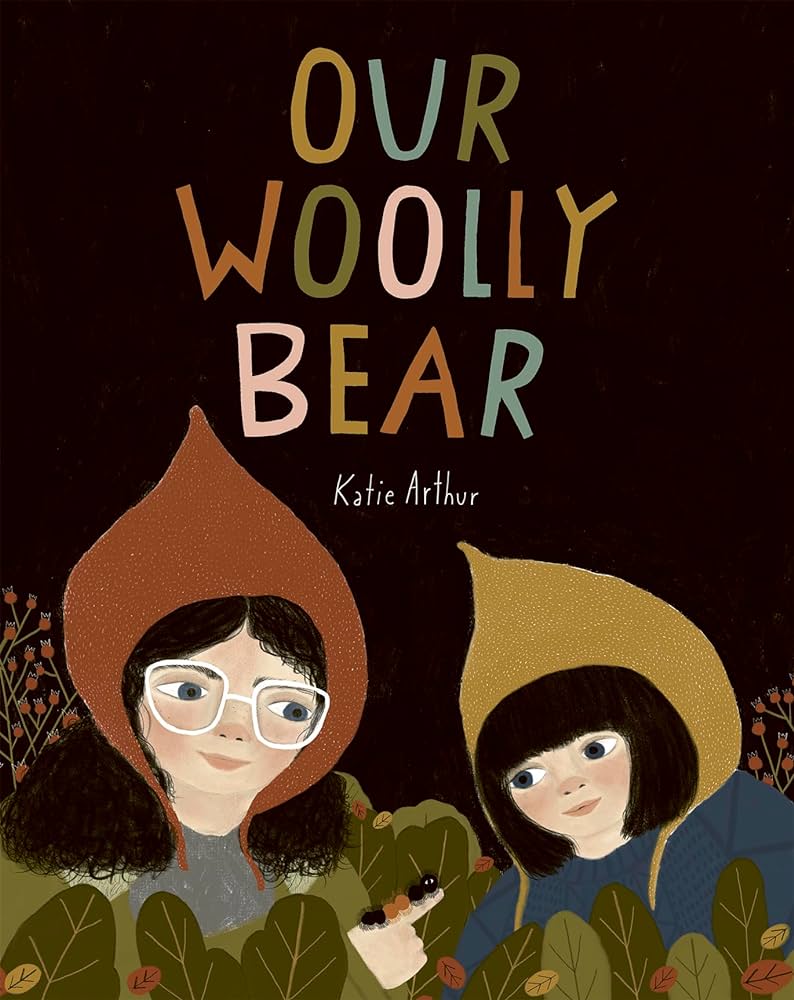Our Wooly Bear

Our Wooly Bear
Our Woolly Bear, a gentle picture book, is the perfect read for autumn, the season when children are most likely to discover delightful woolly bear caterpillars bustling along the sidewalks or hiding amongst the colourful fallen leaves. Also known as woolly worms, these fuzzy creatures are the larval form of the Isabella Tiger Moth. Found over most of North America, their distinctive banding and bristly appearance captures the curiosity of both youngsters and adults alike. In this story, narrator Edie and her little sister Lou encounter their very own small fuzzy black-and-orange visitor hiding in their vegetable garden amongst the beet greens.
I scoop up the caterpillar and cup her in my hands.
Slowly, softly, I shuttle her to our playhouse.
The caterpillar rolls up like a sleeping bag.
I think she’s nervous.
That means we need to make her feel at home.
Enthralled by their new friend, the girls gather pine needles to make the caterpillar a comfortable home and then eagerly consult their collection of books to learn more about their discovery. Their father, equally intrigued, joins the investigation and uses his computer to help identify the type of caterpillar, revealing that it will transform one day into an Isabella Tiger Moth. A glimpse of his research findings, shared in one illustration, informs readers that these little creatures can survive the winter months despite being frozen solid. Their interest piqued, the sisters begin to look more closely at the flora and fauna around them, and, as the days pass and autumn truly arrives, their curiosity in the natural world captures their fancy in a sparse accompanying text:
We find our woolly bear everywhere.
We find her on the shed steps where we watch the clouds drift in the breeze.
We find her at the dusty end of the lane where we check for parcels.
We don’t find her in our clawfoot tub. So we pretend that she’s there.
We do find her at the walking trail in town, which is more than five entire Beatles songs away from our house.
Everyone on the trail wants to meet our Woolly Bear.
Slowly, softly, they touch their fingers to her bristles.
But when the last leaves begin to fall, leaving crunchy piles on the cold ground, something happens.
Woolly Bear disappears.
Does Edie describe the same Woolly Bear or more than one? Where might a little caterpillar go when it disappears? What do you do inside and outside during November when the weather turns cold? Children will be inspired to share their ideas about activities related to the rhythm of seasonal change and eager to share their predictions about Woolly Bear’s next adventure. Those with the sharpest eyes might just spot the unheralded appearance of a small moth on the book’s final pages.
The emergence of these little Woolly Bears offers a fabulous opportunity for youngsters to observe caterpillars up close, keep records as to their eating habits, care for them, and possibly even watch them moult and transform into the moth stage of their life cycle. The story suggests using close observation, books, and digital resources to learn more about the Woolly Bear. There are many online nature videos available to extend readers’ interest, with the Santa Barbara Museum of Natural History offering a free pdf guide on how to raise these little creatures.
However, not all readers of this picture book may have access to these additional sources. Several factual pages and photographs providing background information about the caterpillars would have been a welcome addition to this book. It might also have been interesting to address the folklore associated with this highly recognizable species of caterpillar. Some believe that Woolly Bear caterpillars can predict the winter weather by consulting the width of their black bands on each end and comparing them to the rusty-coloured one in the middle. If the black bands are significantly wider, supposedly the upcoming winter should be more severe.
Our Woolly Bear is a debut picture book for Nova Scotia based author and illustrator Katie Arthur. She has successfully captured the beauty and marvel of small things in this exploration of nature. Hide and seek elements throughout its pages mimic the realism of having to look closely to spot these caterpillars. Thanks to Arthur’s choice of a warm and earthy colour palette of browns, greens, and golds to reflect the fall season, the little Woolly Bear is beautifully camouflaged amongst the illustrations. Although the finished product is reminiscent of a painted and collaged style, Arthur’s artwork was completed digitally using an iPad. The textures and patterns of nature are contrasted by white negative spaces and an assortment of unpredictable and intriguing page layouts from multi-panels to full-page spreads. The quilt designs, clothing choices, activities, and landscapes subtly reflect the setting’s Nova Scotian themes. There is even a surprise homage to Eric Carle’s original caterpillar book, The Very Hungry Caterpillar, to be found amongst Arthur’s fanciful illustrations.
This picture book would be a fine introduction to the small wonders of nature and provide the perfect segue towards fostering an appreciation and curiosity of the local environment. Our Woolly Bear is recommended as an addition to school library collections and as an outstanding gift choice for any youngster with an interest in bugs.
Joanie Proske is a retired Langley elementary and secondary teacher-librarian who now lives on Vancouver Island in British Columbia. She fondly remembers her own grandmother taking her for walks through the garden to search for woolly bear caterpillars and together making wishful predictions for winter weather.
